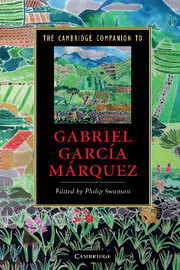Book contents
- Frontmatter
- Introduction
- 1 Gabriel García Márquez: life and times
- 2 The critical reception of García Márquez
- 3 Before One Hundred Years of Solitude: the early novels
- 4 One Hundred Years of Solitude
- 5 An eco-critical reading of One Hundred Years of Solitude
- 6 The Autumn of the Patriarch
- 7 The General in His Labyrinth
- 8 García Márquez’s novels of love
- 9 García Márquez’s short stories
- 10 García Márquez’s non-fiction works
- 11 García Márquez and film
- 12 García Márquez, magical realism and world literature
- Further reading
- Index
8 - García Márquez’s novels of love
Published online by Cambridge University Press: 28 September 2010
- Frontmatter
- Introduction
- 1 Gabriel García Márquez: life and times
- 2 The critical reception of García Márquez
- 3 Before One Hundred Years of Solitude: the early novels
- 4 One Hundred Years of Solitude
- 5 An eco-critical reading of One Hundred Years of Solitude
- 6 The Autumn of the Patriarch
- 7 The General in His Labyrinth
- 8 García Márquez’s novels of love
- 9 García Márquez’s short stories
- 10 García Márquez’s non-fiction works
- 11 García Márquez and film
- 12 García Márquez, magical realism and world literature
- Further reading
- Index
Summary
Whatever else one might say about García Márquez's view of love, his treatment of it is remarkably consistent. That view shows love as an irresistible force that overwhelms the rational mind and sweeps those in its grasp to the margins of conventional society. Social practices and institutions are anathema to the kind of passionate obsessions explored in Chronicle of a Death Foretold (Crónica de una muerte anunciada [1981]), Love in the Time of Cholera (El amor en los tiempos del cólera [1985]), Love and Other Demons (Del amor y otros demonios [1994]) and Memories of My Melancholy Whores (Memoria de mis putas tristes [2004]). Small wonder that love is at times confused with virulent diseases such as cholera and rabies, which cause their victims to be placed in quarantine. Love can seem a distinctly dangerous affliction. And it is an affliction almost always suffered by men - the women's (or usually adolescent girls') stories of love are mere glimpses. Men's suffering seems to bear out the notion that 'nothing in this world is more difficult than love', though fundamentally in García Márquez there is nothing remotely to compare with love's intoxicating wonder. Chronicle of a Death Foretold focuses on how society impedes the fulfillment of individual lives. In particular, it shows how the most important aspects of human experience are obstructed because social conventions take priority. Unlike the other novels considered here, love does not drive the narrative in Chronicle of a Death Foretold.
- Type
- Chapter
- Information
- The Cambridge Companion to Gabriel García Márquez , pp. 113 - 128Publisher: Cambridge University PressPrint publication year: 2010
- 2
- Cited by

